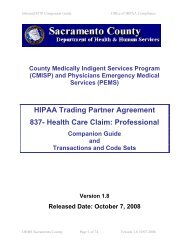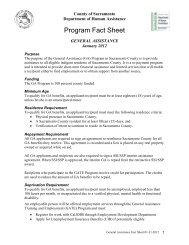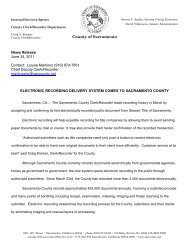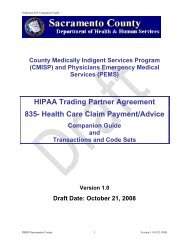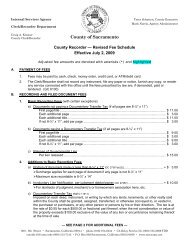Caring Matters - Sacramento County IHSS Public Authority
Caring Matters - Sacramento County IHSS Public Authority
Caring Matters - Sacramento County IHSS Public Authority
You also want an ePaper? Increase the reach of your titles
YUMPU automatically turns print PDFs into web optimized ePapers that Google loves.
HealthThe Best Way to Treat Pressure Sores is PREVENTION!by Terry McPeek, RNEskaton Senior ConnectionThe largest organ in the body is one that many people don’t think of as an organ at all– your skin! Skin care is especially important to those who are bed-bound because theirskin is under more stress than most. Those who are bed-bound must be regularly turnedfor comfort and to protect against pressure sores.Our skin is nourished by tiny blood vessels which deliver fresh blood, containing oxygenand nutrients to the tissues. Deprived of those necessities, the skin tissues begin to die.A pressure sore, also known as a decubitus (de-kyu-bi-tus) ulcer or “bed sore” can beginwith something as simple as a skin tear or a red area on the skin. As we age, the skinbecomes thinner and loses fat beneath the upper layer, increasing the risk of developingthese lesions, which result from unrelieved pressure on the skin. But age is not the onlyfactor - anyone who is unable to move around in bed easily is at risk of developing thesepainful sores.There are several ways to reduce the risk of developing pressure sores:• Positioning: Use pillows and foam padding to keep limbs and body in place. Transitionto a new position at least every two hours. If the person can sit in a chair, theposition should be changed hourly. Positioning should always be done to reduce pressureover the bony points on the body such as hip bones, tailbone, shoulder blades and heels.• Reduce friction on skin: Even soft sheets can cause friction when rubbing over thesame area repeatedly. Watch heals and the tips of the toes for sheet friction and “tent” thesheet over the feet if necessary. When turning a bed bound person you can use a lift sheetto prevent “dragging” the body over bedding.• Inspect and protect skin: Check the person’s skin for tears or red areas. Think of apressure sore as an “iceberg.” While you can see the “tip” of the iceberg (a small red area)the affected area is actually much larger, beneath the underlying layers of skin. Never rubdirectly on a red patch or pressure sore – the goal is to increase circulation to surroundingtissues to promote healing. If a red mark is present after relieving pressure from the areafor more than a few hours, call your health care provider for advice.• Hydration and Nutrition: While it is important for any client to receive propernutrition and fluids, it is particularly the case with anyone recuperating from a bed sore.***As previously stated, a persistent red mark is a cause for concern as is any broken skin thatdoes not heal quickly. Seek immediate medial care if you detect signs of infection, fever,drainage or an odor or increased heat and redness in the surrounding skin.




